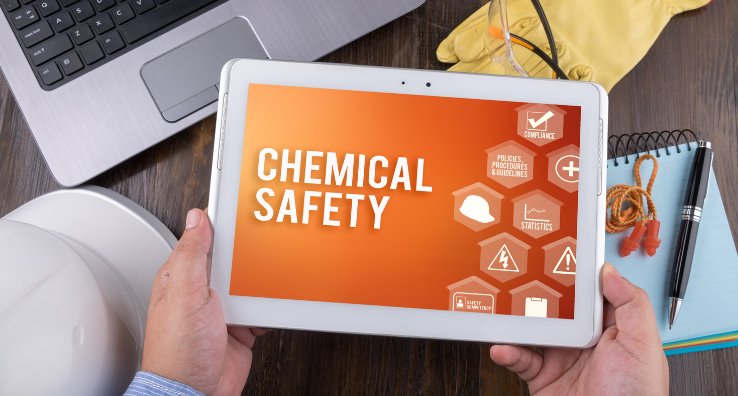5 Ways to Reduce Slips, Trips, and Falls in 2022

When making safety resolutions for 2022 don’t slip up and forget about the most common source of workplace injuries. Slips, trips and falls mishaps undoubtedly will continue to challenge manufacturing safety practices this year. So, while much attention will be placed on hot-topic issues like employee retention and Covid-19, don’t lose focus and stumble on the basics.
Slips, trips and falls in the workplace are responsible for nearly 16 million injuries each year. They are the second leading cause of fatalities on the job and the third leading cause of employee disability. Last year, slips, trips and falls played a major role in more than 84% of all non-fatal injuries involving days away from work. And they remain among the most common reasons for lawsuits, OSHA penalties, and hits on productivity
As you start the new year, now’s the perfect time to refresh training programs to teach employees how to avoid slips, trips and falls in the workplace – inside and outside.
The CDC places most falls under two categories – elevated and same level. Same-level falls are more common and cause more injuries. However, elevated falls produce more severe injuries to fewer people. Over 60% of all elevated falls, according to the CDC, are from a height of less than 10 feet.
OSHA frequently inspects workplace environments for greasy or wet surfaces and areas with unprotected sides and edges where someone can fall from an elevated level. The agency requires working surfaces to be kept clean, workroom floors dry, walking surfaces free of hazards, and stairs to have three treads and four risers per flight.
Also, OSHA requires employers to maintain processes and procedures for employees to quickly identify risks. Employers are then required to demonstrate how they address the issues in a timely manner. You’ll be expected to report how you’re conducting regular and periodic inspections and maintenance of all walking surfaces in your workplace.
You’ll also need to show how you’re training employees to recognize the hazards that can lead to slips, trips and falls. As you do that, keep these five areas in mind.
Teach Employees How to Use Fall Prevention Equipment
Your employees should always have easy access to fall prevention equipment like harnesses, safety lines, and hard hats. But the real trick is teaching them how to use it properly. And it’s far more than knowing how to wear the equipment. Your training needs to cover how to properly think ahead and use the equipment in a way that ensures protection.
For example, do they know how far the extension equipment will reach before starting their ascent? Are they practiced and comfortable using it? And first and foremost, are processes in place to regularly inspect that equipment prior to use?
Make Employees More Aware of Their Surroundings
Working in the same environment every day can numb your senses to the dangers around you. Anyone can zone out and go on autopilot at their station. But that’s when they lose sight of what can hurt them and their co-workers, especially when it comes to slips, trips and falls. For example, they might ignore wet surfaces, even with signs in place indicating floors have been freshly mopped. Or they might take multiple steps at a time on the stairs and not use handrails.
These little oversights can produce big injuries and subsequent claims. You can reduce these incidents by including them in your ongoing safety training. Teach employees how to spot and help prevent risks and how to report them. Also, consider cultivating behavior-based safety to encourage employees to behave in a manner that helps reduce their risk exposure.
Don’t Allow Playtime During Worktime
The line between harmless and risky playtime is virtually indistinguishable. It’s one thing to have fun at work, but it’s entirely different when it puts employees at risk. The safest course of action is to enforce a zero-tolerance policy against horseplay at work. That includes no running, skipping, pushing, playing ball, or roughhousing at work. What is horseplay? You’ll know when you see it.
Create a Safe Walk to and from the Parking Lot
A lot can happen between where employees park their cars and enter the building. Make sure your walkways are clear of water, ice, snow, or anything that might cause someone to slip and fall. This includes sanding or de-icing walkways. Point out where slippery surfaces can develop. Also, take time to inspect for uneven walkways or items that might trip employees. Provide proper lighting to identify risks and illuminate pedestrian walkways.
Teach Ladder Safety
Ladder safety is a common area for OSHA inspections, and injuries if left unchecked. Train employees how to use ladders safely, and constantly inspect them for safety. Keep ladders free of dirt and grime and inspect for any issues that might compromise their integrity. And help employees know how to pick the right ladder for the job.
So, while you’re making those annual safety resolutions that might seem undeniably necessary or unusual given our history with the pandemic these last couple of years, don’t forget the basics. Eliminate the opportunity for the basic causes behind slip, trips and falls. And contact us if you need any help with comprehensive training to prevent slips, trips and falls.





